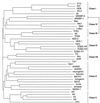Helix-loop-helix proteins: regulators of transcription in eucaryotic organisms
- PMID: 10611221
- PMCID: PMC85097
- DOI: 10.1128/MCB.20.2.429-440.2000
Helix-loop-helix proteins: regulators of transcription in eucaryotic organisms
Figures


Similar articles
-
Comparative analysis of promoter regions containing binding sites of the heterodimeric transcription factor Ino2/Ino4 involved in yeast phospholipid biosynthesis.Yeast. 2005 Jun;22(8):601-13. doi: 10.1002/yea.1209. Yeast. 2005. PMID: 16034810
-
Differential activities of murine single minded 1 (SIM1) and SIM2 on a hypoxic response element. Cross-talk between basic helix-loop-helix/per-Arnt-Sim homology transcription factors.J Biol Chem. 2002 Mar 22;277(12):10236-43. doi: 10.1074/jbc.M110752200. Epub 2002 Jan 8. J Biol Chem. 2002. PMID: 11782478
-
Cardiovascular basic helix loop helix factor 1, a novel transcriptional repressor expressed preferentially in the developing and adult cardiovascular system.J Biol Chem. 2000 Mar 3;275(9):6381-7. doi: 10.1074/jbc.275.9.6381. J Biol Chem. 2000. PMID: 10692439
-
Role of helix-loop-helix proteins in lymphocyte development.Cold Spring Harb Symp Quant Biol. 1999;64:39-44. doi: 10.1101/sqb.1999.64.39. Cold Spring Harb Symp Quant Biol. 1999. PMID: 11232313 Review. No abstract available.
-
Structure/function relationships in OmpR and other winged-helix transcription factors.Curr Opin Microbiol. 2002 Apr;5(2):135-41. doi: 10.1016/s1369-5274(02)00310-7. Curr Opin Microbiol. 2002. PMID: 11934608 Review.
Cited by
-
PTBP3 Induced Inhibition of Differentiation of Gastric Cancer Cells Through Alternative Splicing of Id1.Front Oncol. 2020 Aug 18;10:1477. doi: 10.3389/fonc.2020.01477. eCollection 2020. Front Oncol. 2020. PMID: 32974175 Free PMC article.
-
Twist1 as a target for prevention of cutaneous squamous cell carcinoma.Mol Carcinog. 2023 Jan;62(1):62-76. doi: 10.1002/mc.23482. Epub 2022 Nov 13. Mol Carcinog. 2023. PMID: 36373194 Free PMC article.
-
NeuroD2 regulates the development of hippocampal mossy fiber synapses.Neural Dev. 2012 Feb 27;7:9. doi: 10.1186/1749-8104-7-9. Neural Dev. 2012. PMID: 22369234 Free PMC article.
-
Personalized approach of medication by indirect anticoagulants tailored to the patient-Russian context: what are the prospects?EPMA J. 2012 Sep 27;3(1):10. doi: 10.1186/1878-5085-3-10. EPMA J. 2012. PMID: 23016735 Free PMC article.
-
Building muscle: molecular regulation of myogenesis.Cold Spring Harb Perspect Biol. 2012 Feb 1;4(2):a008342. doi: 10.1101/cshperspect.a008342. Cold Spring Harb Perspect Biol. 2012. PMID: 22300977 Free PMC article. Review.
References
-
- Ahmad I. Mash-1 is expressed during ROD photoreceptor differentiation and binds an E-box, E opsin-1 in the rat opsin gene. Brain Res Dev Brain Res. 1995;90:184–189. - PubMed
-
- Alland L, Muhle R, Hou H, Jr, Potes J, Chin L, Schreiber-Agus N, DePinho R A. Role for N-CoR and histone deacetylase in Sin3-mediated transcriptional repression. Nature. 1997;387:49–55. - PubMed
Publication types
MeSH terms
Substances
LinkOut - more resources
Full Text Sources
Other Literature Sources
Molecular Biology Databases
